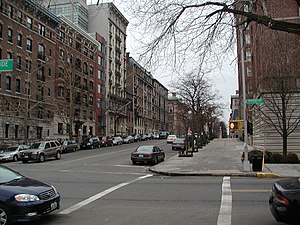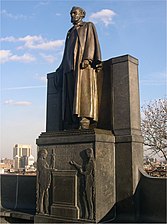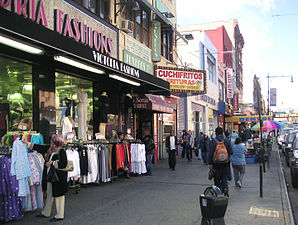116th Street (Manhattan)
40°48′05″N 73°56′53″W / 40.8013366°N 73.948073°W
Manhattan | |
| West end | Riverside Drive |
|---|---|
| Major junctions | Broadway at Columbia University |
| East end | FDR Drive |
116th Street runs from
History
The street was designated by the Commissioners' Plan of 1811 that established the Manhattan street grid as one of 15 east-west streets that would be 100 feet (30 m) in width (while other streets were designated as 60 feet (18 m) in width).[1]
Description
West Side
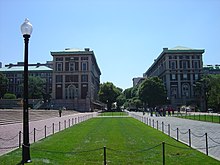
The western entrance to 116th Street at Riverside Drive is flanked by a pair of white apartment buildings with curved facades,
The New York Times has said that the "opposing curves, (form) a gateway as impressive as any publicly built arch or plaza in New York.[2] The unusual curves of the road are the result of an 1897 plan to make the land between Claremont Avenue and Riverside Drive into a public park in order to give veterans parades with a large park adjacent to Grant's Tomb as a terminus. The street was redesigned so that a vehicle or a parade coming up Riverside Drive would swing onto 116th Street in a gracious curve, then immediately swing north onto Claremont Avenue following a second curve. The city never appropriated funds to buy the land, but the curves remain.[2] The top of The Paterno is capped with an architectural fancy masking a water tower in a shape that conjures up a section of Mansard roof, complete with dormer window. It is visible from the gates of Columbia University at Broadway and 116th Street.
The intersection of 116th Street and
East Side
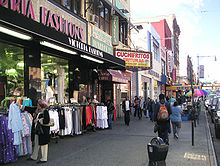
The main, east-west thoroughfare portion of 116th Street begins at the eastern edge of Morningside Park and runs east through central Harlem. A large
At Lenox Ave., the street runs past the Malcolm Shabazz Mosque, formerly the
East of
Transportation
Subway stations on 116th Street are, from west to east:
- Frederick Douglass Boulevard
- Lenox Avenue
- Lexington Avenue
The future
when constructed.The
In popular culture
116th Street in Harlem is the background for the book The Street (1946) by Ann Petry. The story is about Lutie Johnson, a single young black mother, who moves to 116th Street to give her son better opportunities.
116th Street and Broadway is the opening scene of The Caine Mutiny (1951) by Herman Wouk as Willie Keith is being dropped off by his mother to join the Navy in World War II.
Gallery
-
Termination of 116th Street at Riverside Drive
-
Looking west fromMorningside Parkis behind the camera.
-
Carl Schurz statue at the 116th Street overlook at Morningside Park.
-
Morningside Avenue, east side of the park. 115th Street buildings in background.
-
Adam Clayton Powell Jr. Boulevard and Eighth Avenue in Harlem.
-
Malcolm Shabazz Mosque, 116th and Lenox Avenue.
-
El Barrio, 116th Street between Third Avenue and Lexington Avenue.
See also
- 116th Street Crew, a Mafia crew with the Genovese crime family
- Ciro Terranova, the "Artichoke King" moved to 138 East 116th Street after declaring bankruptcy and foreclosing on his home
- Morello crime family, the Morellos owned the building at 338 East 116th Street, the headquarters of the Aignatz Aflorio Co-operative association
References
- ^ Morris, Gouverneur, De Witt, Simeon, and Rutherford, John [sic] (March 1811) "Remarks Of The Commissioners For Laying Out Streets And Roads In The City Of New York, Under The Act Of April 3, 1807", Cornell University Library. Accessed June 27, 2016. "These streets are all sixty feet wide except fifteen, which are one hundred feet wide, viz.: Numbers fourteen, twenty-three, thirty-four, forty-two, fifty-seven, seventy-two, seventy-nine, eighty-six, ninety-six, one hundred and six, one hundred and sixteen, one hundred and twenty-five, one hundred and thirty-five, one hundred and forty-five, and one hundred and fifty-five--the block or space between them being in general about two hundred feet."
- ^ a b Gray, Christopher (August 15, 1999). "Streetscapes/The Colosseum and the Paterno, 116th Street and Riverside Drive; At Curves in the Road, 2 Unusually Shaped Buildings". The New York Times.
- ^ "COLUMBIA PUTTING NEW WALK IN SHAPE; Transformation of 116th Street Block Into a Campus Artery Moving Toward Completion". The New York Times. November 17, 1953. Retrieved August 21, 2008.
- ^ Attah, Ayesha. "Mourides Celebrate 19 Years in North America". The AfRican. Archived from the original on March 22, 2009. Retrieved October 23, 2007.
116th Street in Harlem, New York is aptly named Le Petit Senegal. It abounds in aromas of stewing mafe and yassa wafting out of restaurants, sidewalks turned into mosques and businesses stocked with merchandise right out of Dakar
- ISBN 978-0-8129-3107-5.
- ^ "East River Plaza". PlanNYC. Archived from the original on June 25, 2009. Retrieved August 25, 2009.
- ^ Pristin, Terry (June 11, 2008). "Squeezing Big-Box Retailing Into Small City Spaces". The New York Times. Retrieved August 25, 2009.


